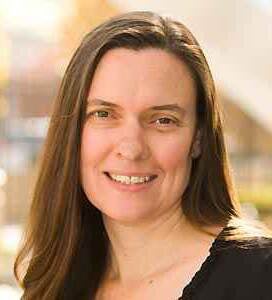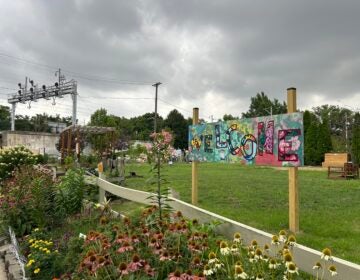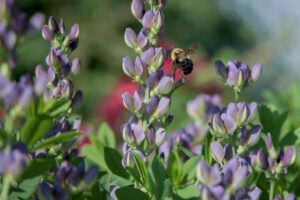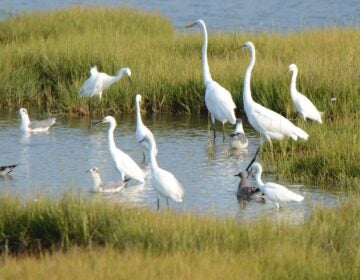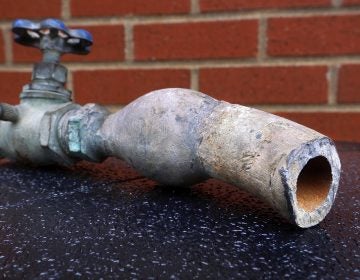Climate Fixers: Native plants, no mow and DIY fertilizer in Roxborough
At Love ‘N Fresh Flowers in Northwest Philadelphia, Jennie Love teaches the benefits of native plants and DIY fertilizer. All you need are weeds and a bucket!
This story is part of the WHYY News Climate Desk, bringing you news and solutions for our changing region.
From the Poconos to the Jersey Shore to the mouth of the Delaware Bay, what do you want to know about climate change? What would you like us to cover? Get in touch.
In a far corner of Northwest Philadelphia, down a narrow bumpy lane that feels more like a country road than a street within city limits, rows of false indigo, foxglove, sweet William and dahlias play host to the buzz of multiple species of pollinators — but no lawnmowers and certainly no rototillers will ever be heard here.
These six acres of land in Roxborough are stewarded by Jennie Love, owner of Love ‘N Fresh Flowers. While she now uses the land for her cut flower farm, the deeds trace all the way back to Philadelphia’s founding Quaker William Penn, who Love says rented it to tenant farmers.
Love said the land has never been developed.
“For a long time, it was fallow and sort of abandoned before I got here,” she said. “I’ve been farming it since 2009, so I feel really lucky to do that.”
Love calls herself a “habitat farmer,” because she practices what is known as regenerative farming.
“So that means that we’re focused on healing the ecosystem and supporting habitat as much as we are on producing a crop,” Love said. “I’m trying to produce a habitat. And then my reward is to harvest some beautiful flowers and share them with my community.”
Love grew up on a central Pennsylvania dairy farm, went to college and ended up working in corporate business and marketing for 10 years.
“But then once I was in this space and I could just see the ecosystem humming, and the more work that I did and the more I supported it, the more it thrived.”
She said she went down a “biome” rabbit hole, learning everything she could about restoring the soil. But now, she says, what drives her is climate change.
“Because the work that I do, the work that any farmer anywhere around the globe does, is in peril. We are about to lose our livelihoods because this work is getting harder and more dangerous,” she said. “With extreme heat, extreme storms, it’s very perilous to be out in the field sometimes.”
Love’s goal now is to model positive change with regenerative farming techniques, prove that they can work, and inspire others.
“Because it can really feel daunting, like, ‘Oh my gosh, climate change. We’re doomed,’” she said.
Native plants and pollinators
On a hot summer day, Love shows us a row of false indigo, or baptisia, a tall flower native to this region that has dozens of little flowers in columns growing up the top of the stalk like a spear.
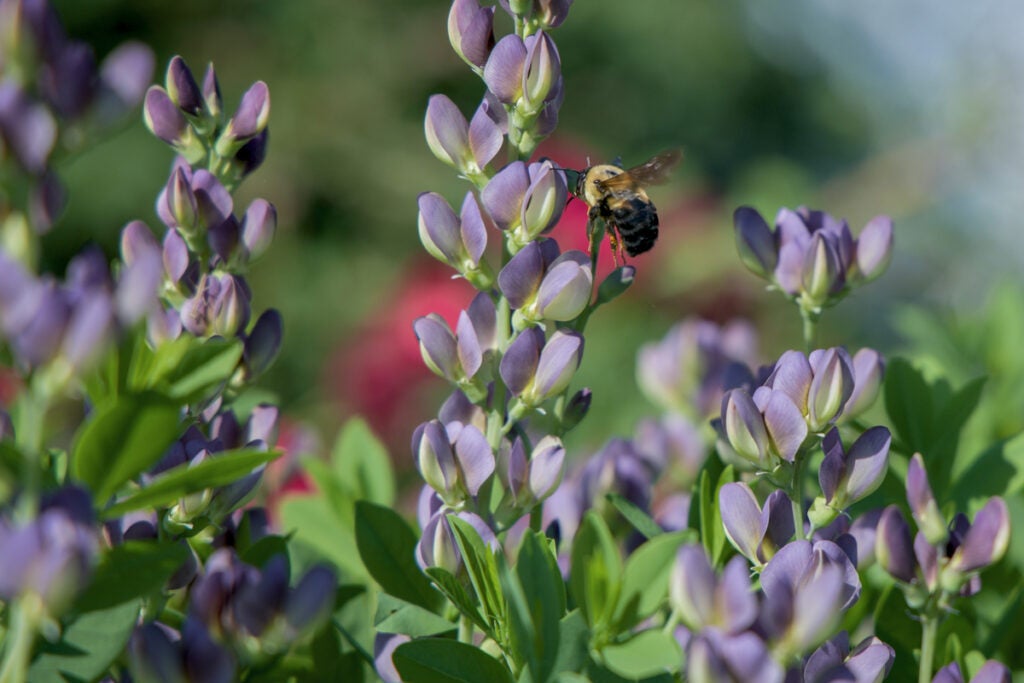
“It’s just really a magical plant for the ecosystem because those are very deep taproots, which really helps the soil. It helps sequester more carbon,” she said. “And then little native bumblebees love, love, love this plant! So they pollinate each and every one of those little flowers. And they dig in there and they get a nice drink and some pollen.
“It’s great for your garden, it’s great for the ecosystem, and it’s a great bouquet. So we grow about nine varieties here. There’s dark purple, light purple and almost blue. the bright yellow, a very soft, buttery yellow, a soft sort of plum pink color.”
Love can’t plant all natives to support her flower business, but she says she does focus on as many natives as possible, because she said they help boost soil health.
“These plants have evolved over millennia with the native soil microbes and all the different life that is in the soil,” she said. “So they know how to support our local biome.
“When we bring in plants that are not native, they’re kind of like strangers. And even if they do adapt, it takes a long time. So it’s a lot better to just put the native plant in place. It’s so much better for the ecosystem and the biome.”
Native plants are also adapted to our climate, which makes them hardier, and prone to less disease and pests.
“So the native plants tend to be more resilient, and they’re the ones that are going to get us through climate change,” she said.
Although, as the climate warms, some plants that have thrived in this region for generations, will no longer survive, especially those that need a cold winter like lilacs and peonies.
“I have loads of lilacs at this farm,” said Love. “And this year was a terrible lilac year because we’ve hit that cusp where now I just don’t think they’re going to thrive anymore. And soon they just won’t grow here at all.”
No tilling, no mowing, no fertilizer
Another important part of regenerative farming is allowing the soil to sequester as much carbon as possible, and that means no tilling, which breaks up the soil and damages useful microbes.
“Tilling is incredibly invasive and hard on the soil,” said Love. “It releases tons of carbon. It’s actually, frankly, increasing climate change.”
Instead, Love focuses on planting perennials that only have to be planted once thereby lessening the soil disturbance. She likes to refer to it as “lazy farming.”
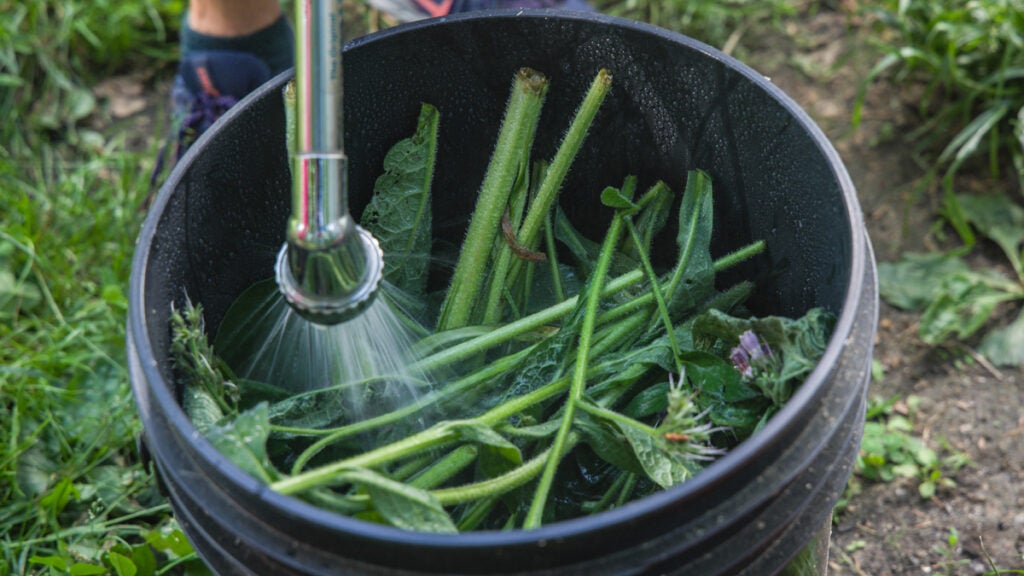
“When we’re ready to change a crop out, we just cut the crop down at the base of the soil and then we leave the roots of the old plants in the ground, and they just compost in place in the ground. And then that creates this really rich, loamy soil without any extra effort,” she said.
She points to the tall grass that grows between her rows of flowers, and in patches around the farm, which she never mows.
“There’s a pest that lives in the grass called thrips, this teeny tiny little insect,” she explained.
“These are a huge problem for flower farmers because they tend to get on the flowers and cause damage. So thrips live in the grass. And if I was to mow, they would leave the grass and go into the flowers, and then I’d be stuck with a big pest problem, and I would have to spray something to get rid of them,” she said.
If she doesn’t mow, she said, the thrips stay in the grass. Another reason for not mowing is that she uses the grass in her flower arrangements.
“Just look at these amazing seed heads. I mean, there’s so many different kinds of seed heads when you let the grasses grow tall,” she said. “But one of the things that’s really important about this is, it’s where insects live.”
Insect populations have dropped 45% in the past 40 years, according to an analysis of 16 individual studies, which is, in part, attributable to mowing.
“And then we’re spreading chemicals on them. And we’re not giving these insects habitats. And when we lose the insects, we’re losing the birds. So we’ve lost 3 billion birds in my lifetime. That’s crazy,” Love said.
She said an easy solution is to just not mow.
As for fertilizer, Love encourages people to make their own with weeds or garden clippings.
On a recent afternoon, she chopped up some comfrey, put it in a bucket and poured rainwater over it. She warns that if you use tap water make sure to have it sit out for a day without a lid so the chlorine evaporates, otherwise the chlorine will kill microbes needed for decomposition. After she puts a strong lid on the bucket that seals it from the air, she says that in about six weeks’ time, it may smell like sewer gas, but it makes a great fertilizer.
“It’s free, it’s fast, and it’s a really fun science experiment,” she said.
Once you’ve got your homemade fertilizer, Love suggests putting a quarter cup of it in a watering can, filling the can with a gallon of fresh water, and then watering the plants.
“We’re really just thinking more about supporting the entire community,” said Love. “And by entire community, I mean insects and birds and animals, everybody — instead of just focusing on our own needs and our own production. So if every single person who has even just a small part of land did the same things at home, we could have such an impact.”

Get daily updates from WHYY News!
WHYY is your source for fact-based, in-depth journalism and information. As a nonprofit organization, we rely on financial support from readers like you. Please give today.


